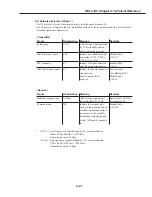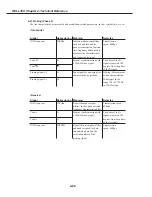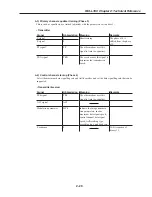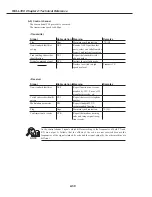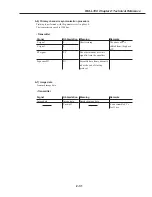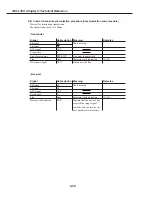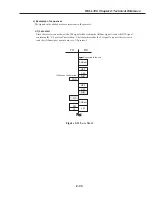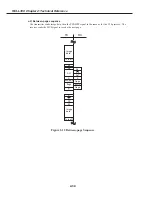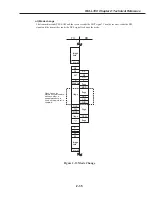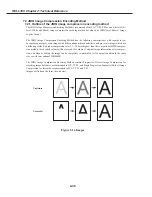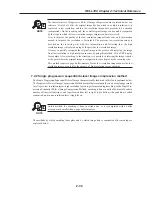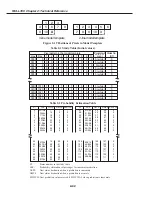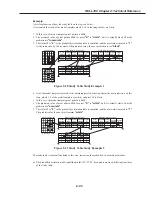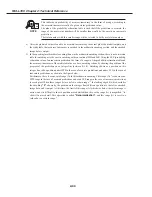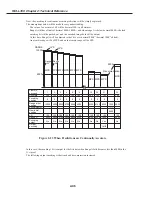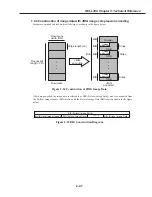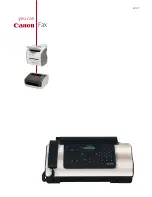
2-40
FAX-L350 Chapter 2: Technical Reference
7.2.3 Encoding method
In the JBIG encoding used in the Single Progression Sequential Bi-level Image Compression Method, uses
in the encoder shown below to encode to the original the results of comparison of the line currently being
processed and the previous line, as well as the predicted value of an image pixel (white or black) used in a
model template.
The study table used in the prediction makes the next prediction more accurate by learning and correcting
the study table every time the model template moves to the adjoining pixel. It is characteristic of this method
that if the prediction is accurate the amount of encoding will not increase, and if the prediction is off the
amount of encoding increases, so the increase in prediction accuracy of this study table is very important.
An outline of the encoding procedure is shown below.
Figure 2-17 Encoder and Flow of JBIG Encoding
a) In the pattern prediction section, the line currently being processed and the current line are compared,
and judged to match or not match. A flag showing whether or not the lines match (1 bit, 0: match, 1: don't
match) is attached to the head of each line according to this judgment. When the lines match, only this
flag is encoded in the arithmetic encoding section as a suspected pixel, the pixel of the line being cur-
rently processed is not encoded. When the lines do not match, the pixel of the line currently being
processed is encoded in the arithmetic encoding section based on the results of a comparison of the value
of the actual pixel and the pixel (white or black) which is predicted using the model template and the
study table.
When the lines are judged to match, the line currently being processed is said to be
“typical”
. When the lines are judged to not match, the line is said to be
“not typical”
.
When the very first line of an image is predicted, the background color is used as the
previous line.
Image data
input
Output of image data
encoded by JBIG
Output of match/no match
Comparison of current
and previous lines
Prediction of pixel
to be encoded
No-match path
Pixel to be encoded
(For comparison against prediction)
Prediction of pixel using
10-bit pixel pattern
Next prediction based on
prediction results
Relevant status area reference
Refer to the next status and pixel prediction
based on the prediction results (Learning)
Prediction and status reference
and predition results
ENCODER
TYPICAL
PREDICTION
MODEL
TEMPLATE
10-bit pixel
pattern
ARITHMETIC
ENCODING
STUDY
TABLE
PROBABILITY
ESTIMATION
TABLE
NOTE
Summary of Contents for FAX-L350
Page 2: ......
Page 6: ...III III REVISION HISTORY REVISION CONTENT 0 Original ...
Page 11: ...VIII This page is intentionally left blank ...
Page 12: ...Chapter 1 General Description ...
Page 13: ......
Page 30: ...1 17 FAX L350 Chapter 1 General Description This page intentionally left blank ...
Page 56: ...Chapter 2 Technical Reference ...
Page 57: ......
Page 60: ...2 3 FAX L350 Chapter 2 Technical Reference This page intentionally left blank ...
Page 64: ...2 7 FAX L350 Chapter 2 Technical Reference This page intentionally left blank ...
Page 68: ...2 11 FAX L350 Chapter 2 Technical Reference This page intentionally left blank ...
Page 109: ...2 52 FAX L350 Chapter 2 Technical Reference This page intentionally left blank ...
Page 110: ...Chapter 3 Maintenance and Service ...
Page 111: ......
Page 197: ...3 86 FAX L350 Chapter 3 Maintenance and Service This page intentionally left blank ...
Page 198: ...Chapter 4 Appendix ...
Page 199: ......
Page 211: ...4 12 FAX L350 Chapter 4 Appendix This page intentionally left blank ...
Page 212: ......


